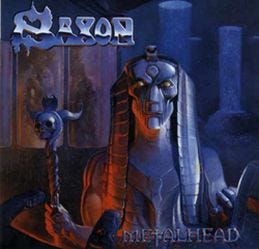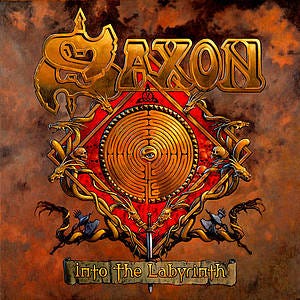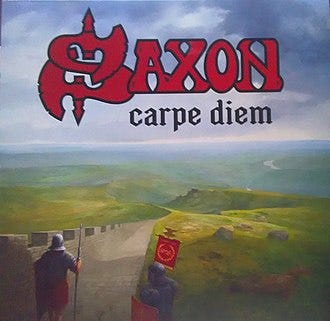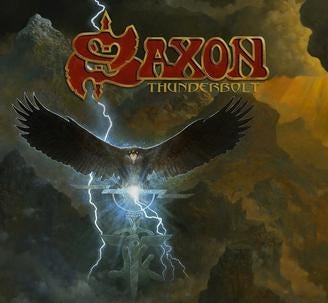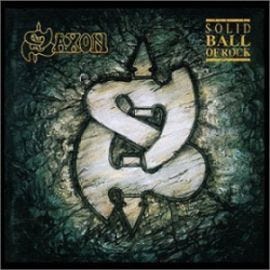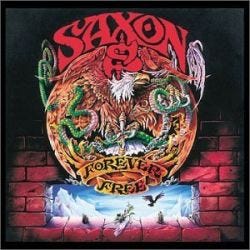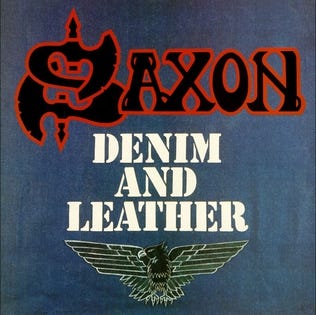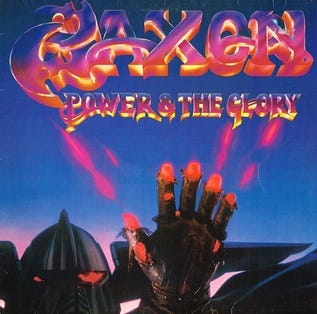Ranking the (Studio) Albums: Saxon (Part III: #12-5)
The "hey, these are actually quite good" records
This cluster of Saxon albums represent the very good/almost great portion of their discography, a rather large subset that reflects how often the band came superclose to something majestic. And indeed, many of these albums (sprinkled throughout their entire career) are fan favorites, and the final two on this list would rank among the very best for a vocal segment- and maybe they actually are. To these ears, they’re really good but maybe missing those one or two things that would truly push them over the top.
Let’s get to it…
#12: Metalhead (1999)
Nigel Glockler left a second time shortly after Unleash the Beast came out, and was replaced by German power metal veteran Fritz Randow. Perhaps as a result, Metalhead worked a little harder to live up to its title, including more overtly metallic production from Charlie Bauerfeind (another German power metal veteran). The writing and overall approach by the band was generally consistent with their last couple records, but there was a bit more clarity here, with the alternately stomping and lurching title track, “All Guns Blazing” and “Conquistador” raging with purpose. Metalhead suffered from a lack of proper distribution (Saxon was once again without an American label), but bolstered the group’s standing in mainland Europe, continuing their steady march back to headliner status on the festival circuit.
Rating: 3.5/5
#11: Into the Labyrinth (2009)
“Battalions of Steel” perfectly reflected what Saxon was trying to accomplish with the return of Nigel Glockler on drums one album earlier: his ageless double-kick fury remained an inspiration to power metal, adding another dimension to Biff Byford’s distinctly British aesthetic. Into the Labyrinth was a logical continuation of The Inner Sanctum, but was also arguably more NWOBHM than we’d heard from Saxon in a very long time, and that gave the album an extra charge that showed exactly what they continued to bring the table over 30 years after their debut. More than that, the writing was there as well, with “Valley of the Kings” and “Demon Sweeney Todd” charging in fine form.
Rating: 3.5/5
#10: Carpe Diem (2022)
Saxon’s most recent album was not only the latest in a staggeringly consistent run, but it was also a reminder that even now, when the guys put out a new record it’s about even odds that it would rank among their best. Carpe Diem wasn’t that exactly, but it was tight and focused and played to their strengths as a band: “Super Nova” and “Age of Steam” ruled, and of course the title track was a prototypical Saxon ripper. Maybe the record as a whole wasn’t as smashing as their greatest works, but there was absolutely nothing embarrassing or lame here, which was a hell of a lot more than could be said of most of their contemporaries.
Rating: 3.5/5
#9: Thunderbolt (2018)
Every few records, Saxon will decide that they need to come back heavier, and so it was with Thunderbolt, which was not only fleeter and crunchier than Battering Ram but also boasted a belligerent guest appearance from Johan Hegg of Amon Amarth. In fact, the album was probably heavier than it needed to be, as tunes like “The Secret of Flight” and “Sniper” were already written as straight-up bangers before Andy Sneap’s production set everything to stun. But when they’re focused, Saxon is nigh on unstoppable, and Thunderbolt lived up to its premise.
Rating: 3.5/5
#8: Solid Ball of Rock (1991)
Saxon finally got their shit together in time for the ‘90s. Chastened and left for dead after their attempts at courting the mainstream backfired spectacularly, Saxon made three crucial moves: first and foremost, they abandoned any hope of major American success and deliberately chose to commit to true-blue heavy metal and for all; second, they convinced Nigel Glockler to return; and perhaps most significant in the long run, Tim “Nibbs” Carter was not only brought in on bass, but was able to contribute to the writing in a meaningful way. This latter development proved crucial, as Carter’s “Altar of the Gods” and “Baptism of Fire” were easily the most frenetic, intense and focused tracks Saxon had put out in 8 years. Solid Ball of Rock wasn’t initially well received critically, but it sold reasonably well in Europe (at the very least it staunched the bleeding) and over time has actually held up better than one would expect- even the cheesiness of "Requiem (We Will Remember)" was balanced out by its hooks and the clear affection in Biff’s singing and lyrics.
Rating: 3.5/5
#7: Forever Free (1992)
If Solid Ball of Rock was a much-needed reset for Saxon, Forever Free proved they were committed to their new direction and not only did what was needed to solidify their improved standing in mainland Europe, but brought the band favorable notices (if not proper distribution) in the US and UK. The writing was sharper, with the title track restoring their biker metal bonafides while the monstrous “Hole in the Sky” and “Nighthunter” were straight-up facemelters. Even the slower “Iron Wheels” worked. This would rank even higher were it not for a strangely muted and stiff recording- Biff later regretted producing by himself, a decision likely borne from wanting to record quickly and maintain their momentum. But even though the mix dulled Forever Free a touch, the songs hold up remarkably well and some (like the aforementioned “Nighthunter”) are among the best they’ve ever written.
Rating: 3.5/5
#6: Denim and Leather (1981)
Just like Forever Free, Denim and Leather also suffered from an anemic production that diluted some of the power in the material. After all, the barnstorming “Princess of the Night”, “Never Surrender”, “And the Bands Played On” and the definitive title track remain evergreen to this very day. And as a collection of songs, this record did every bit as much to define Saxon as a band as their previous couple records. But while a huge portion of Saxon’s fanbase are willing to excuse the poor production and chalk it up to low NWOBHM-era budgets, almost every noteworthy metal album released around this time sounded better, and it gets harder to overlook how meek Denim and Leather actually sounds when compared to not only Killers, but also Saxon’s own earlier discography.
Rating: 3.5/5
#5: Power & the Glory (1983)
Speaking of production… whereas Denim and Leather had a mix that, while considered perfectly acceptable at the time, ultimately sounds tamer with each passing year, Power & the Glory was initially criticized for what was considered an overly brash and fried recording from Jeff Glixman, but actually supercharged the songs by accentuating the power and aggression in the band’s performance. The album benefited from a change of scenery (not to mention the arrival of the mighty Nigel Glockler on drums), with Saxon recording in America and using that as a springboard to gain some ground there, and as a result the material was more direct and intentional, with “Warrior” and especially the charging title track aiming straight between the eyes. But while the other songs weren’t quite as consistent, the closing epic “The Eagle Has Landed” was a moody dark horse that ably positioned Saxon as a band that, alongside Iron Maiden, could transcend the New Wave of British Heavy Metal. Power & the Glory actually remains a divisive album among the group’s base, with some considering it their first misstep since the debut and others (most notably Martin Popoff) calling it their best album ever. Here it pops up at the top of the “almost there” records, coming really close but not quite making it due to the presence of some filler tracks in the middle.
Rating: 3.5/5




